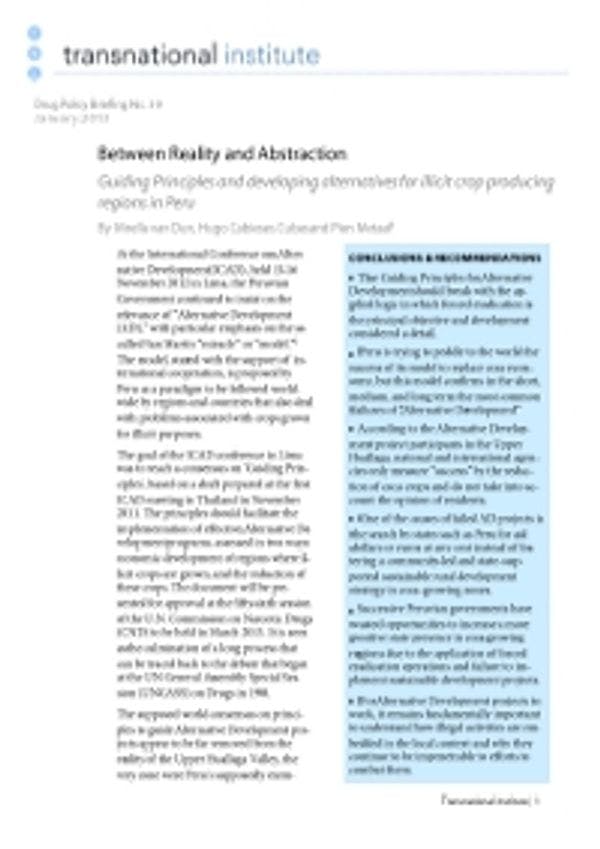Entre réalité et abstraction: Principes directeurs et alternatives de développement pour les régions productrices de drogues au Pérou
Lors de la Conférence internationale sur le développement alternatif de Novembre 2012, le gouvernement péruvien a continué de promouvoir l’importance du développement alternatif pour les régions productrices de drogues. Pour en savoir plus, en anglais, veuillez lire les informations ci-dessous.
Abonnez-vous à l'Alerte mensuelle de l'IDPC pour recevoir des informations relatives à la politique des drogues.
At the International Conference on Alternative Development (ICAD), held 15-16 November 2012 in Lima, the Peruvian Government continued to insist on the relevance of “Alternative Development (AD),” with particular emphasis on the so-called San Martín “miracle” or “model.” The model, started with the support of international cooperation, is proposed by Peru as a paradigm to be followed worldwide by regions and countries that also deal with problems associated with crops grown for illicit purposes.
The goal of the ICAD conference in Lima was to reach a consensus on 'Guiding Principles', based on a draft prepared at the first ICAD meeting in Thailand in November 2011. The principles should facilitate the implementation of effective Alternative Development programs, assessed in two ways: economic development of regions where illicit crops are grown, and the reduction of these crops. The document will be presented for approval at the fifty-sixth session of the U.N. Commission on Narcotic Drugs (CND) to be held in March 2013. It is seen as the culmination of a long process that can be traced back to the debate that began at the UN General Assembly Special Session (UNGASS) on Drugs in 1998.
The supposed world consensus on principles to guide Alternative Development projects appear to be far removed from the reality of the Upper Huallaga Valley, the very zone were Peru's supposedly exemplary model for Alternative Development is being implemented. This briefing exposes the breach between rhetoric and reality by examining the impact of AD projects in Peru, focussing on its impact on peasant families.
The experience of Upper Huallaga shows, like many other AD projects, severe limitations in these programmes' goals of reducing coca-production and achieving the broader aims of sustainable development. They reach relatively few farmers, with “beneficiaries” accounting for less than one quarter of the farmers in the region. They promote monocrop cultivation in a biological diverse area, resulting in severe environmental impacts. Their success relies on large-scale production for export in an area that is not apt for this kind of farming due to its ecological fragility and soil quality. Finally the programmes are unsustainable over time because they depend on international demand and prices of the products it promotes: cacao, coffee, palm heart, palm oil and sugar cane.
The key question that the international community should ask when the document is discussed during the CND in March 2013 in Vienna is if these Guiding Principles will help break the failed logic applied until now, which has prioritised forced eradication and added development as an afterthought. In addition, given that this is an issue that goes to the heart of rural development, it is essential to identify the stakeholders these projects are geared to and to define if the development model promoted is appropriate to meet the stated goal.
Keep up-to-date with drug policy developments by subscribing to the IDPC Monthly Alert.
